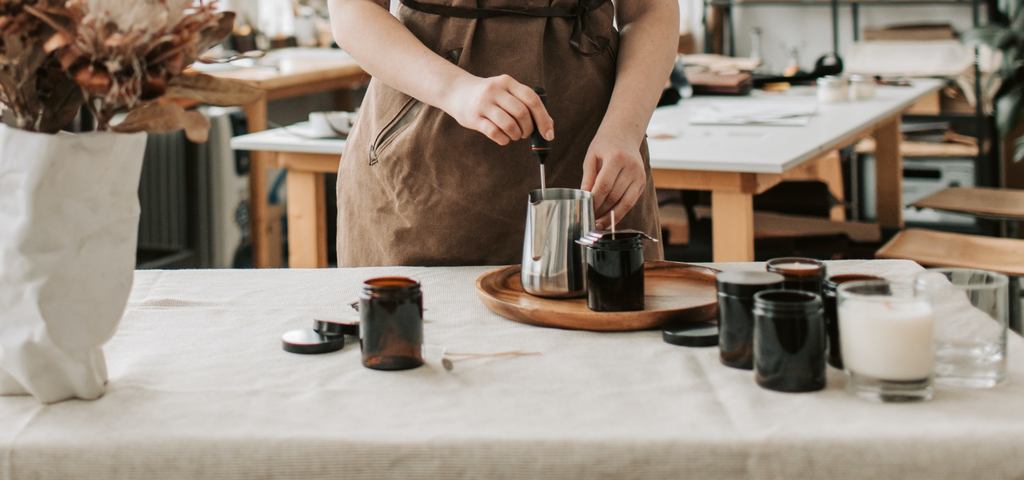Adding the correct amount of fragrance oil (FO) to your candles is one of the most important steps in making candles that burn nicely and smell strong. However, it also helps to understand how wax temperature affects the performance of your candles.
Many candle makers worry about getting their wax to a specific temperature before adding their FO, but there isn’t necessarily a magic number. You don’t need to overthink wax temperatures too much when it comes to mixing your fragrance oils. In most cases, as long as the wax is fully melted and you stir your FO until it completely dissolves, the fragrance will have bonded with the wax.
Why does wax temperature matter?
Although your wax temperature doesn’t need to be exact, you do need to keep a few things in mind when heating your wax. When wax is too cool or too hot, you won’t get the results you’re looking for. For example, some waxes – such as soy – can discolor or undergo other changes when they are heated too hot. To prevent discoloration, you’ll usually want to avoid heating soy waxes (and soy blends) beyond 185° F.
While discoloration might be specific to soy wax, you shouldn’t heat any wax to an excessively high temperature (around 245° F or higher). If you over-heat your wax, you may cause the wax to undergo chemical changes, which can alter its ability to bond with fragrance oils at all.
On the other hand, if you add fragrance oil to wax that is too cool, the FO won’t be able to dissolve properly. In this situation, you will likely end up with fragrance oil pooling at the bottom of your melt pot that refuses to incorporate with your wax regardless of how much you stir.
When in doubt, you can always refer to the temperature recommendations from the wax manufacturer. With most waxes, there is a somewhat wide temperature range where fragrance oils can be successfully added. In the end, doing your own testing is the best way to find your ideal wax temperature.
It's a good idea to use a thermometer when making candles so that you can accurately tell the temperature of your wax. This way you won't have to guess whether your wax is too hot or too cold. Furthermore, if you're making large batches of candles, you can get more consistent results by making sure you're at your ideal wax temp when adding fragrance to each batch.
What if my wax is hotter than my FO’s flash point?
We’ve talked about flash points a lot in our blog. This is another instance where it’s important to understand what they are and how they work. When it comes to fragrance oils, the term “flash point” is used in a legal context to identify which substances can be safely transported on an airplane. You can read all about what flash points really mean for more information. We also discuss situations where flash points do matter for candle making in our blog about adding the right amount of fragrance oil to your candles.
If you make a lot of candles, there’s a pretty good chance that you’ll eventually find yourself working with a fragrance oil that needs to be added to wax that is hotter than the FO’s flash point. However, this shouldn’t prevent you from using fragrance oils with a flash point on the lower end.
Because many candlemakers fear that their oils will burn off if the wax is too hot, they may not ever get their wax warm enough for proper bonding to take place. Consider that some fragrance oils have a flash point of less than 140° F, yet most types of wax need to be heated beyond 140° F in order to melt to the point that they’re even able to bond with fragrance.
When using oils with a low flash point, heating your wax to a temperature below the flash point will not cause the fragrance to perform better. In fact, you are more likely to hinder the scent throw of your candle if the wax never gets hot enough to bond with the fragrance oil.
Making candles takes a lot of trial and error, but testing can also be fun. Thankfully, nothing can go too terribly wrong if you end up over or under-heating your wax, as long as you follow basic candle making safety precautions. When testing gets frustrating, don’t forget that making mistakes is sometimes the best way to learn!
You Might Also Like: How to Test Candles for Safety and Compatibility



6 comments
I accidentally heated my soy wax too long and the colour turned to darker yellow and it has a mild burn smell. Can I still use the wax? Any way i can still salvage the wax? Thanks in advance!
I’m having a problem with air bubbles in my candles after they are cooled. Using a soy/parrafin mix and pouring at 180 degrees. Any suggestions?
Hi Peter, thank you for taking the time to read our blogs! I’m glad to hear they have helped you. When it comes to essential oils, one of the drawbacks is that they often don’t perform well in candles. This is because they are pure plant extracts, whereas fragrance oils are formulated with ingredients that enhance the scent throw. Because essential oils don’t include these ingredients, it’s often impossible to get the same level of scent you would from a fragrance oil. I would recommend that in order to get essential oils to bond with the wax, you would still want to make sure the wax gets to around 185. However, this won’t necessarily help with scent throw. The good news is that many fragrance oils are formulated with essential oil ingredients. Although they will also contain synthetic ingredients, this is sometimes the best solution for getting better scent throw. You could try mixing essential oils with fragrance oils to get a higher ratio of essential oil in your scent mix.
Hi I’m glad I found your site giving me better understanding of flash points which was confusing me. One thing I’m really struggling with is a rough guideline as to when to add essential oils to soy wax.
I’ve tried different temperatures and still struggling to get a hot throw.
As a rough guide what temperature would you advise to add essential oil’s to melted wax?
Kind regards Peter
Hi Roxanne! We’re so happy to hear that you’ve found our resources to be helpful! Thank you for giving our wicks a try – we’re glad to hear that they are working well for you. We also have a handy wick chart with helpful tips on choosing wicks for different containers & wax: https://northwoodcandlesupply.com/blogs/news/wick-size-chart-guide-to-choosing-a-candle-wick